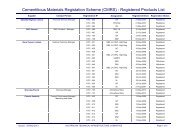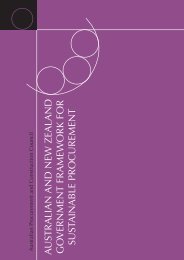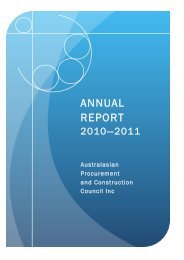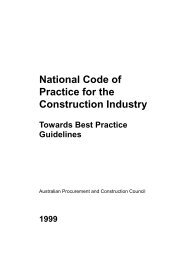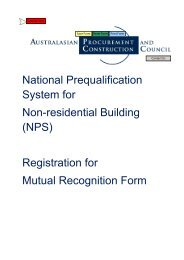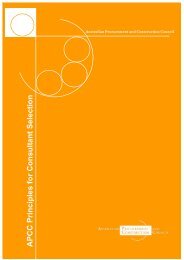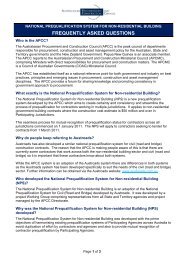ESD design guide for Australian Government buildings: Edition 2
ESD design guide for Australian Government buildings: Edition 2
ESD design guide for Australian Government buildings: Edition 2
You also want an ePaper? Increase the reach of your titles
YUMPU automatically turns print PDFs into web optimized ePapers that Google loves.
esd opportunities in building<br />
OPPORTUNITY 3<br />
optimising indoor environment quality<br />
PROJECT<br />
PRODUCTIVITY<br />
INCREASES<br />
ING bank (Netherlands) 14 15% IEQ<br />
San Fran Sustainable<br />
3% to 15% IEQ<br />
studies (US) 15 Development Committee<br />
REASON<br />
Nevada Post office (US) 16 6% Better lighting and use of natural<br />
light.<br />
Verifone Corporation (US) 17<br />
Twelve Public Offices (US) 18<br />
45% decrease in<br />
absenteeism<br />
Table 3. Summaries of several productivity studies.<br />
Daylighting, air filtration and low<br />
toxicity material specification.<br />
Mechanically ventilated <strong>buildings</strong><br />
had significantly more people<br />
with symptoms of sick building<br />
syndrome than occupants of<br />
naturally ventilated <strong>buildings</strong>,<br />
after adjustment <strong>for</strong> confounding<br />
factors.<br />
Indoor Environment Quality (IEQ)<br />
is mainly assessed on by how<br />
the environment in the building is<br />
perceived by it users, as well as some<br />
empirical measurements of air flow<br />
and temperature. It is made up of<br />
various elements:<br />
• Indoor Air Quality (IAQ), assessed<br />
by the levels of pollutants in the air,<br />
odour etc.<br />
• Ventilation,<br />
• Thermal com<strong>for</strong>t,<br />
• Lighting (including provision of<br />
natural light),<br />
• Noise and<br />
• Visual amenity.<br />
IMPORTANCE OF IEQ<br />
IEQ is important because people<br />
spend around 90% of their time<br />
indoors. 10 Minimising the toxicity of<br />
their indoor environment is there<strong>for</strong>e a<br />
priority, particularly when indoor air is<br />
shown to be more toxic than outdoor<br />
air. 11 The US EPA estimates that 20 to<br />
35 percent of all workers in modern<br />
mechanically ventilated <strong>buildings</strong> may<br />
experience negative air-quality related<br />
signs and symptoms. 12 Furthermore,<br />
it declares that indoor pollution is<br />
estimated to cause thousands of<br />
cancer deaths and hundreds of<br />
thousands of respiratory health<br />
problems each year.<br />
A 1984 World Health Organization<br />
Committee report suggested that up<br />
to 30 percent of new and remodelled<br />
<strong>buildings</strong> worldwide may be the<br />
subject of complaints related to indoor<br />
air quality. 13<br />
Several studies have established links<br />
between increased productivity and<br />
improved IEQ. Some of these studies<br />
are shown in Table 3.<br />
10 Wargocki, P., Wyon, D.P., Baik, Y.K., Clausen, G.<br />
and Fanger, P.O. (1999) Perceived air quality,<br />
Sick Building Syndrome (SBS) symptoms and<br />
productivity in an office with two different pollution<br />
loads. Indoor Air, p 9, 165–179 and<br />
Fisk, W.J. and Rosenfeld, A.H. (1997), ‘Estimates<br />
of Improved Productivity and Health from Better<br />
Indoor Environments’, Indoor Air, vol. 7 (3), pp.<br />
158-172<br />
11 Patrick K (2004) ‘IEQ : Coming To A Building<br />
Near You’, Property Australia, Property Council of<br />
Australia: Sydney, p. 8<br />
12 ibid p. 8<br />
13 ibid p. 8<br />
14 ibid p. 9<br />
15 ibid p. 10<br />
16 Edwards L. and P. Torcellini (2002) A Literature<br />
Review of the Effects of Natural Light on Building<br />
Occupants, National Renewable Energy Laboratory<br />
p. 11 www.ornl.gov/sci/hybridlighting/pdfs/NREL_<br />
TP_550_30769.pdf<br />
17 ibid p. 10<br />
18 Fisk, W.J. and Rosenfeld, A.H. (1997) ‘Estimates<br />
of Improved Productivity and Health from Better<br />
Indoor Environments’, Indoor Air, vol. 7 (3), pp.<br />
158-172.<br />
“…Indoor Environment Quality…<br />
in the past few years it has<br />
probably been the single biggest<br />
thing that has come up and has<br />
got these <strong>buildings</strong> over the<br />
line…”<br />
Importance of IEQ<br />
CH2 (6 Star Green Star - Office Design v1)<br />
Stephen Webb, Director, DesignInc<br />
Melbourne<br />
<strong>ESD</strong> DESIGN GUIDE FOR AUSTRALIAN GOVERNMENT BUILDINGS 015


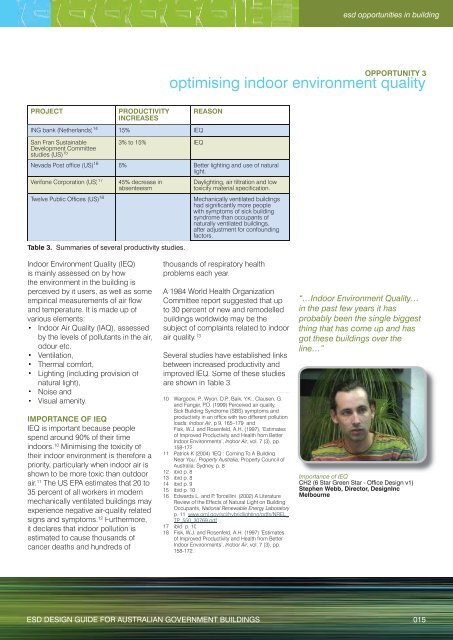
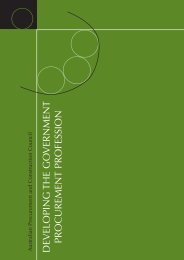
![NATIONAL COST ADJUSTMENT PROVISION EDITION 2 [NCAP2]](https://img.yumpu.com/48266135/1/184x260/national-cost-adjustment-provision-edition-2-ncap2.jpg?quality=85)

